Steatoda capensis
| Steatoda capensis | ||||||||||||
|---|---|---|---|---|---|---|---|---|---|---|---|---|

Steatoda capensis , female |
||||||||||||
| Systematics | ||||||||||||
|
||||||||||||
| Scientific name | ||||||||||||
| Steatoda capensis | ||||||||||||
| Hann , 1990 |
Steatoda capensis is a spider from the family of the canopy web spiders (Theridiidae). It belongs to the genus of fat spiders ( Steatoda ), but can easily be confused with the spiders of the genus Real Widows ( Latrodectus ). It is less dangerous than the true widow representatives, but its bite can also be quite painful. In New Zealand it was often confused with the native red katipo ( Latrodectus katipo ) or its black color variant and was given the name False Katipo (False Katipo).
description
The females reach a body length of about 9 millimeters, the males remain slightly smaller. They are colored glossy black or dark brown. The legs of the females are brown to black in color, those of the males are light green or orange in color with dark joints.
In shape and size it is similar to the Katipo species from the genus Latrodectus , some specimens of Steatoda capensis have a faint and red stripe on the abdomen. The False Katipo differs from the Katipo species by the arrangement of the white markings on the abdomen and the less pronounced red stripes on the abdomen. In addition, the hourglass-like drawing on the underside of the abdomen is missing in Steatoda capensis . The lateral eyes of Steatoda capensis touch or are less than the diameter of the eye apart, those of Latrodectus katipo are one eye diameter apart. The egg cocoons of the False Katipo appear a little fluffier, more untidy and more open than those of the Red Katipo. Steatoda capensis breeds in New Zealand all year round, Latrodectus katipo only in the winter months.
Occurrence and habitat
The species originally comes from South Africa , but was introduced to Australia and New Zealand . It is common throughout South Africa and the most common type in and on homes. In New Zealand the false katipo occupies the same habitats on beaches as Latrodectus katipo . It may replace L. katipo , among other things because of its higher reproduction rate.
Way of life
The species feeds on small insects .
Taxonomy
Steatoda capensis was first described as Teutana lepida in 1903 by Octavius Pickard-Cambridge , a British arachnologist . As early as 1897, Pickard-Cambridge had a New Zealand spider from the family of crested- web spiders named Lithyphantes lepidus . In 1957 Herbert Walter Levi found that both Lithyphantes and Teutana should be understood as synonyms of the genus Steatoda . All species with these two generic names thus belong to the genus Steatoda . A conflict arose for Lithyphantes lepidus and Teutana lepida , because after the renaming both species should have been called Steatoda lepida . Since Lithyphantes lepidus was the species described earlier, it was named Steatoda lepida according to the priority rule . For Teutana lepida , SW Hann suggested the new name (nomen novum) Steatoda capensis in 1990 , since the first described specimen of this spider was found in Cape Town .
literature
- SW Hann: A new combination involving Lithyphantes lepidus Cambridge 1897 and a new name for Teutana lepida Cambridge 1903 (Araneae, Theridiidae). New Zealand Journal of Zoology, 17, p. 283, 1990
- SW Hann: Descriptions of four Steatoda species (Araneae, Theridiidae) found in New Zealand. New Zealand Journal of Zoology, 21, pp. 225–238, 1994 full text (PDF)
- SW Hann: Evidence for the displacement of an endemic New Zealand spider, Latrodectus katipo Powell by the South African species Steatoda capensis. New Zealand Journal of Zoology, 17, pp. 295-307, 1990 preview at books.google.de
Individual evidence
- ↑ a b Black cobweb or false katipo spider at www.tepapa.govt.nz (Engl.)
- ↑ a b SW Hann: Descriptions of four Steatoda species (Araneae, Theridiidae) found in New Zealand. New Zealand Journal of Zoology, 21, pp. 225–238, 1994, p. 226 PDF at www.royalsociety.org.nz (English, accessed May 2, 2010)
- ↑ MAF Biosecurity New Zealand: False katipo spider at www.biosecurity.govt.nz (English, accessed May 1, 2010)
- ↑ a b Marion E. Sutton, Brendon R. Christensen, and John A. Hutcheson: Field identification of katipo Online (PDF; 227 kB) at www.doc.govt.nz (English, accessed on May 2, 2010)
- ^ A b SW Hann: Evidence for the displacement of an endemic New Zealand spider, Latrodectus katipo Powell by the South African species Steatoda capensis. New Zealand Journal of Zoology, 17, pp. 295–307, 1990 preview at books.google.de (English, accessed on May 2, 2010)
- ↑ Description page on www.landcareresearch.co.nz (Engl.)
- ^ Octavius Pickard-Cambridge: Descriptions of some New Species and Characters of Three New Genera, of Araneidea of South Africa. Annals of the South African Museum, 3, 5, pp. 143–166, Cape Town 1903 Scan of the original at the Biodiversity Heritage Library
- ^ Octavius Pickard-Cambridge: Proceedings of the Zoological Society London, pp. 681-703, London 1897
- ^ Herbert W. Levi: The spider genera Crustulina and Steatoda in North America, Central America, and the West Indies (Araneae, Theridiidae). Bulletin of the Museum of Comparative Zoology, 117, pp. 367-424, Harvard 1957
- ↑ SW Hann: A new combination involving Lithyphantes lepidus Cambridge 1897 and a new name for Teutana lepida Cambridge 1903 (Araneae, Theridiidae). New Zealand Journal of Zoology, 17, p. 283, 1990 preview at books.google.de (English, accessed May 7, 2010)

